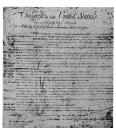The Bill of Rights: the Story Behind the Amendments
Yet nowhere in the Constitution is a list of things the government cannot do. The American people were deeply concerned about their rights under the new government. Even if this new government looked to be a great improvement over the monarchy that the people had just overthrown, the blueprint of the new government didn't guarantee its people such natural rights as freedom of religion and freedom of speech. (Many colony governments had.)
They came up with the Bill of Rights. Next page > The First Amendment > Page 1, 2, 3, 4, 5 Graphics courtesy of ArtToday |
|
Social Studies for Kids
copyright 2002–2025
David White



 The
The  And
yet, here was the Constitution, waiting to be signed and
approved by enough delegates and enough states to declare it
law. Protection of natural rights wasn't really in the
Constitution, so the delegates had to invent a place to put
them.
And
yet, here was the Constitution, waiting to be signed and
approved by enough delegates and enough states to declare it
law. Protection of natural rights wasn't really in the
Constitution, so the delegates had to invent a place to put
them.

